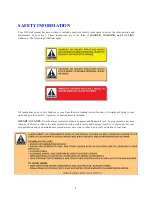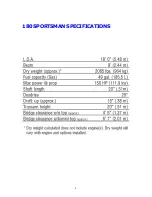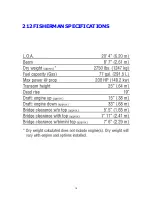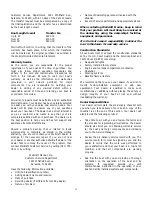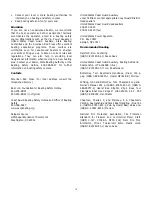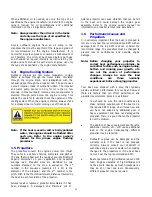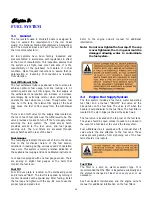
Note: Some states and localities have legal limits
on speed, noise and trailer specifications.
It is your responsibility to be aware of
these laws and limits and to insure that
your boat complies. Consult with your
local Marine Patrol or local Coast Guard
office.
Registration and Numbering
Federal law requires that all undocumented vessels
equipped with propulsion machinery be registered in the
State of principal use. A certificate of number will be
issued upon registering the boat. These numbers must
be displayed on your boat. The owner/operator of a boat
must carry a valid certificate of number whenever the
boat is in use. When moved to a new State of principal
use, the certificate is valid for 60 days.
In order to be valid, the numbers must be installed to
the proper specifications. Check with your dealer or
state boating authority for numbering requirements. The
Coast Guard issues the certificate of number in Alaska;
all others are issued by the state.
Insurance
In most States the boat owner is legally responsible for
damages or injuries he or someone else operating the
boat causes. Responsible boaters carry adequate liability
and property damage insurance for their boat. You
should also protect the boat against physical damage
and theft. Some States have laws requiring minimum
insurance coverage. Contact your dealer or State
boating authority for information on the insurance
requirements in your boating area.
Reporting Boating accidents
All boating accidents must be reported by the operator
or owner of the boat to the proper marine law
enforcement authority for the state in which the accident
occurred. Immediate notification is required if a person
dies or disappears as a result of a recreational boating
accident.
If a person dies or there are injuries requiring more than
first aid, a formal report must be filed within 48 hours.
A formal report must be made within 10 days for
accidents involving more than $500.00 damage or the
complete loss of a boat. The 1994 Recreational Boating
Act may impose a $1,000.00 civil fine for people who fail
to submit a boating accident report.
A Boating Accident Report form is located near the back
of this manual to assist you in reporting an accident. If
you need additional information regarding accident
reporting, please call the Boating Safety Hotline, 800-
368-5647. If you see a distress signal, you must assume
it is a real emergency and render assistance
immediately. The master or person in charge of a boat is
obligated by law to provide assistance to any individual
in danger at sea. However, you should not put your boat
or crew in a dangerous situation which exceeds your
capabilities or those of your boat. The 1971 Boating
Safety Act grants protection to a Good Samaritan boater
offering good faith assistance, and absolves a boater
from any civil liability arising from assistance given.
Required Equipment
U.S. Coast Guard regulations require certain equipment
on each boat. The Coast Guard also sets minimum
safety standards for vessels and associated equipment.
To meet these standards some of the equipment must
be Coast Guard approved. “Coast Guard Approved
Equipment” has been determined to be in compliance
with USCG specifications and regulations relating to
performance, construction, or materials. The equipment
requirements vary according to the length, type of boat,
and the propulsion system. Some of the Coast Guard
equipment is described in the Safety Equipment chapter
of this manual. For a more detailed description, obtain
“Federal Requirements And Safety Tips For Recreational
Boats” by contacting the Boating Safety Hotline 800-
368- 5647, the Coast Guard Office of Boating Safety at
www.uscgboating.org or your local marine dealer or
retailer.
Some state and local agencies impose similar equipment
requirements on waters that do not fall under Coast
Guard jurisdiction. These agencies may also require
additional equipment that is not required by the Coast
Guard. Your dealer or local boating authority can provide
you with additional information for the equipment
requirements for your boating area.
Briefing Passengers
Before each outing, ensure that at least one passenger
is familiar with the proper operation and safety aspects
of the boat in case of emergency. Show all passengers
the location of safety equipment.
Courtesy On-The-Water
• Know the rules of the water and practice them at all
times.
• Be familiar with traffic patterns of the body of water
on which you are boating.
• Give fishermen, sailboats (not under power), and
water skiers plenty of room.
• You are responsible for spotting and avoiding
swimmers and slow-moving vessels.
• You are also responsible for damage caused by your
wake.
• Operate at slow speeds in restricted and congested
areas.
• Keep a lookout for personal watercraft. They have
the same rights and responsibilities as you do.
15
Summary of Contents for 180 Sportsman
Page 2: ...2...
Page 4: ...4...
Page 7: ...180 FISHERMAN SPECIFICATIONS 7...
Page 8: ...180 SPORTSMAN SPECIFICATIONS 8...
Page 9: ...202 FISHERMAN SPECIFICATIONS 9...
Page 10: ...212 FISHERMAN SPECIFICATIONS 10...
Page 18: ...18...
Page 39: ...SAFETY LABELS 2601 1124 39...
Page 40: ...180 FISHERMAN 180 SPORTSMAN CAPACITY LABELS 40...
Page 41: ...202 212 FISHERMAN CAPACITY LABELS 41...
Page 61: ...Appendix A SCHEMATICS 180 FISHERMAN INSTRUMENT PANEL 61...
Page 62: ...Appendix A SCHEMATICS 180 SPORTSMAN INSTRUMENT PANEL 62...
Page 63: ...Appendix A SCHEMATICS 202 212 FISHERMAN INSTRUMENT PANEL 63...
Page 68: ...Appendix A SCHEMATICS 180 FISHERMAN 180 SPORTSMAN TRAILER DRAWING 68...
Page 69: ...Appendix A SCHEMATICS 202 212 FISHERMAN TRAILER DRAWING 69...
Page 70: ...Appendix A SCHEMATICS 180 FISHERMAN OVERHEAD LAYOUT 70...
Page 71: ...Appendix A SCHEMATICS 180 SPORTSMAN OVERHEAD LAYOUT 71...
Page 72: ...Appendix A SCHEMATICS 202 FISHERMAN OVERHEAD LAYOUT 72...
Page 73: ...Appendix A SCHEMATICS 212 FISHERMAN OVERHEAD LAYOUT 73...
Page 77: ...MAINTENANCE LOG 77...
Page 78: ...MAINTENANCE LOG 78...
Page 80: ...Appendix D BOAT ACCIDENT REPORT 80...
Page 81: ...81...
Page 87: ...Appendix F TROUBLESHOOTING GUIDE 87...
Page 88: ...TROUBLESHOOTING GUIDE 88...
Page 89: ...TROUBLESHOOTING GUIDE 89...
Page 90: ...TROUBLESHOOTING GUIDE 90...
Page 91: ...TROUBLESHOOTING GUIDE 91...





